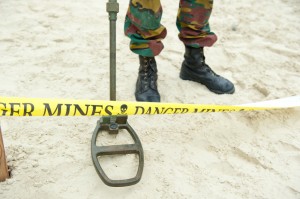Just about everyone reading this is a knowledge worker, so it’s ironic that sometimes our results are affected more by what we don’t know (DK) than by what we know. For example, if you’re in sales, have you ever lost a deal that was a “sure thing”?
If you’ve been in sales for any length of time, it’s probably happened to you. In my case, it was the “big deal of the year” that went to a competitor who saw how well-positioned I was in the decision-making process and successfully went for broke by going directly to the CEO. I had been assured that the CEO would not get involved in the decision, but my competitor changed the rules on me.
It was a very expensive lesson for me, and that is why I’ve learned that one of the most useful personal qualities for a salesperson in complex sales is a bit of healthy paranoia. When everything seems to be lining up just right—that’s when I look extra hard to figure out what can derail the sale.
In any complex sale or persuasion campaign, there is a tremendous amount you know, and there is also a lot you don’t know. These DKs are normal; in a complex situation you will have a lot of DKs and when you admit it to yourself and others at least you can do something about them. The real problems are caused by what we call a (DK)², which occurs when you don’t know that you don’t know something. Some people call them “unk-unks” for unknown unknowns. A (DK)² can kill your deal faster than anything, because you usually find out about it when it is too late.
When things hit the fan, we all love a hero who can rise to the occasion and fix the problem. But if your organization has too many heroes, you’re probably doing a bad job of preventing problems to begin with. Einstein said, “Intellectuals solve problems; geniuses prevent them.”
I hate to disagree with old Albert, but it doesn’t take a genius to prevent problems; a few simple practices described by Michael Roberto in his book, Know What You Don’t Know, will help you a) find problems before they become major and b) get the attention of those who can do something about it.
How to find problems
Get out and look. Listening is not enough, because the gap between what people say they do and what they actually do can be pretty wide. Also keep in mind that the higher you rise in an organization the more likely the information you get is filtered through gatekeepers and several reporting layers. You have to get out and observe people at work. Toyota calls this “getting your hands dirty.”
Get diverse points of view. Salespeople know how important it is to develop coaches within your customer accounts because there is so much information that is not available any other way. But beware of relying too much on a single source. No matter how well connected or well-intentioned, one person simply can’t be everywhere at once, and they will also tend to tell you things from a self-interested point of view. While a coach is good, more than one is better.
Try to surface objections. Intellectually, salespeople know that objections are a good thing because they let us know what stands in the way of making the sale. Psychologically, though, it can be hard to do. Objections tend to grow in importance as you get closer to the decision, so make it easy for your customers to object.
Question your analogies. Learning from experience is usually a good thing, but it can lead to problems. We all tend to reason by analogy, so when we see a situation we compare it to a previous familiar situation. The problem is that we tend to overstress the similarities and deemphasize the differences. Before you make an important decision based on an analogy, take a sheet of paper and brainstorm two columns, one for similarities and one for differences.
Communicate
It’s not always enough to spot signs of an upcoming problem; the right people have to know about it. Sometimes, as in the case of the failure to connect the dots among various intelligence agencies before 9/11, sheer size and complexity makes that extremely difficult. But even in smaller organizations, there is room for improving the flow of information.
Make it safe for people to speak up. In some organizations, people are afraid to speak up even when there is an obvious problem because messengers bearing bad news suffer. Even if your organization is not that harsh, there may be subtle but powerful deterrents to speaking out. Because many signs of an impending problem are not that obvious, there’s a chance of a false alarm and someone may be afraid to speak up without collecting hard data, by which time it might be too late. It’s important to let people know that false alarms are OK.
Meeting facilitation. If you’re a manager, hold back on your opinion until subordinates have a chance to weigh in. Make sure that everyone is heard from and don’t let one or two individuals dominate the discussion. Seek dissent, at least in the early stages. There’s a story about Alfred Sloan, the President of General Motors, who closed a meeting once by saying: “Gentlemen, I take it that we are all in complete agreement on the decision here. Then I propose that we postpone further discussion to give ourselves time to develop disagreement and perhaps gain some understanding of what the decision is all about.”
Teach people how to speak up effectively. A NASA study in 1979 determined that more crashes were caused by failures in communication and leadership than by mechanical problems. One major problem was the mystique of the airline pilot as the top authority onboard—crewmembers who noticed problems were afraid to speak up or did so ineffectively. The aviation industry developed a process called Crew Resource Management (CRM) which has been credited with saving many lives and has spread to hospital operating rooms and firefighting teams, among others.
Being actively alert to what may go wrong does not mean living in fear or being subject to analysis paralysis. On the contrary, knowing your early warning systems are working can boost your confidence and let you charge ahead to your objectives.
One of the best stories I’ve heard about coaching is, strangely enough, a war story. In December 1944 during the Battle of the Bulge in Europe, the German army had smashed a huge hole in the Allied lines. To save the situation, elements of Patton’s Third Army made a rapid left turn and were working their way north to save the situation. The few roads that existed were icy and packed with tanks, trucks and marching men, and the going was slow. At one point, a young battalion commander named Creighton Abrams (yes, the one they later named a tank after) came upon a massive traffic jam caused by a tank that had slid into a ditch, and its inexperienced driver could not get it out.
Abrams jumped into the driver’s seat , jockeyed the gears to rock the tank back and forth and then at the right moment gunned the engine and the tank flew out of the ditch back on to the road. At that point, he asked the driver, “Now do you see how it’s done?” When the driver replied yes, Abrams backed the tank back into the ditch and said, “Good. Now you do it.” And promptly left.
If you’re a sales manager, you should keep this story in mind whenever you are tempted to rescue a sale for one of your reps.
It’s that time of year again: public companies with fiscal years ending on December 31 are issuing their annual reports. Like all good professional salespeople, you know you should get a copy and at least look through it, but honestly, how many of you have already done so?
If you have a hard copy of last year’s report in your files, pull it out and check to see whether the spine has even been cracked. Are sections highlighted, and do you have notes written in the margins? If not, you may have left money on the table this year. But don’t fret, because I’m going to tell you what to look for so you don’t have to read the whole thing and so you can actually get some use out of it.
Why should you even take the time to read it?
 Don’t let the headline fool you, this is not another article about Charlie Sheen. Whether you’re selling a product or an idea, your effectiveness depends on deep knowledge of your “customers”, innovative ideas and extensive preparation. That’s why I‘ve found over my career that the following three personal qualities are indispensable and should be carefully nurtured: curiosity, imagination and paranoia.
Don’t let the headline fool you, this is not another article about Charlie Sheen. Whether you’re selling a product or an idea, your effectiveness depends on deep knowledge of your “customers”, innovative ideas and extensive preparation. That’s why I‘ve found over my career that the following three personal qualities are indispensable and should be carefully nurtured: curiosity, imagination and paranoia.





